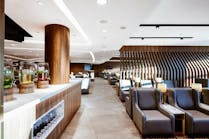No matter where in the world we are traveling, advertising consistently confronts us. From taxi and bus wraps, billboards, digital screens, to point of purchase displays and window banners, it seems there is never a shortage of advertising messages being hurled at us at high speed.
Advertisers are finding that regional and international airports appear to be great places to reach an upscale, highly educated, and discerning audience for their brands. According to The Arbitron Airport Advertising Study published in 2004, “airline travelers are the cream of the crop,” especially those who fly frequently, which is defined as taking four air trips annually. The study estimates that at least one-third of frequent travelers enjoy an annual household income of $100K or more and they are sophisticated shoppers.
Airports have undoubtedly recognized that offering advertising opportunities can have significant benefits, including lucrative financial returns. Thus it appears the search is on for capitalizing on this advertising trend and identifying every square inch in and around airport property that has the potential to carry advertising messages.
Travelers know that even before they get to the airport, there are gigantic billboards with airline and travel advertising, taxi cabs, courtesy shuttles, or airport vans carrying ads vying for traveler’s attention. And, at the TSA security screening, ads are even in the bottom of the plastic containers used with the baggage screening machines.
From the moment you enter the ticketing lobby, walk along the concourse, and arrive at the gate or in the baggage claim area, impressive visuals and enormous size messages appear on digital displays, dioramas, spectaculars, or billboard columns that attempt to capture the attention of passengers in dramatic ways.
I just returned from Budapest, Hungary, whose airport is now named Budapest Franz Liszt International Airport (from Budapest Ferihegy International). As Hungary’s main international airport, it serves more than 8.6 million passengers and has flights to 100 cities from this modern two-terminal facility.
I was immediately impressed by the scale and scope of the advertising displays throughout the airport. Inside the terminals, there were lightboxes, large scale seamless displays above the ticket counters, billboards on columns, and what Clear Channel Outdoor, which manages the airport’s advertising, names a “branding zone.”
I admit, the visuals are impressive and tastefully done: similar to the advertising displays at London’s Heathrow International Airport and at British Airways’ Terminal 5. The terminals seem to “light up” with brightness, almost to the point of needing sunglasses.
I wonder if at some point the airport related advertising will become so overwhelming that passengers will be unable to find a quiet, ad-free space at any airport in the world.
Recently, officials in Medford, Oregon approved the placement of giant corporate logos on the control tower at the city's airport, which is expected to bring $36,000 annually in revenues. Plans are to use the income to help reduce landing fees for airlines which may entice other carriers to serve the airport. We’ll have to see if it works as planned.
At O’Hare International Airport, it seems that no place - including restrooms - are off limits for serving up advertising messages. There, when you walk into the restroom and look in the mirror, instead of seeing your own face, you are greeted by an interactive billboard, which eventually then reverts to the mirror. Now I don’t know about you, but I find this to be way too invasive into my private space.
By contrast, Oslo Airport Gardermoen has taken a ‘less is more’ approach to its advertising concessions. As a newer airport with contemporary architecture, it tries to retain an open, clutter free environment for travelers. Offering fewer advertising sites than most airports, it wants to maintain its clean environment. Currently, there are impressive mega banners, large scale advertising towers and, of course, the digital displays throughout that serve up the ads for some of the world’s biggest brands.
Does airport advertising really work? I came across as study entitled Airport Advertising Effectiveness: An Exploratory Field Study by Rick T. Wilson and Brian D. Till published in the Journal of Advertising, Spring 2008, 37(1), pgs 59-72. (Click on the link above to read the research report)
They tested airport advertising effectiveness and found:
- Ad placement is extremely important – location matters.
- Recognizing how passenger activities affect the ability to process advertising; passengers coming out of security or boarding are more focused on that activity and less likely to notice ads than passengers visiting airport retail outlets.
- Repetition (as one might expect) increases consumer recognition of a brand.
- Uniquely sized and shaped ads are most memorable, as are ads with fewer words.
The trend of airport advertising continues to grow – sometimes in very unusual places.
What do you think? Do we have enough advertising in airports already, or do we need to add more? Are we going to see ads placed on all of the world’s control towers? Or in all airport bathrooms?
# # #
Agnes Huff, PhD, has more than 25 years of experience providing specialized strategic public relations and marketing, crisis management and business consulting to a diverse group of clients in the aviation industry. In 1995, she founded Agnes Huff Communications Group (AHCG) an integrated marketing and PR consulting firm headquartered in Los Angeles. Clients include national and international airports and airlines, government entities, travel and tourism organizations, and transportation companies, among other high-profile industry clients. She welcomes feedback and will respond to comments at [email protected]. More information on AHCG is available at www.ahuffgroup.com.



